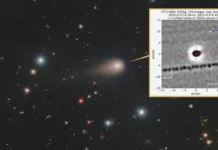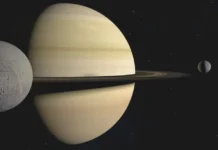Astronomers have traced the origin of the interstellar comet 3I/ATLAS, a celestial traveler that passed through our Solar System at twice the speed of its famous predecessors, ʻOumuamua and Borisov. Using complex galactic simulations involving over 13 million stars, researchers uncovered new clues about where this mysterious object came from — and how it might be a relic from the early days of the Milky Way itself.
🚀 A Visitor From Beyond the Solar System
Earlier this year, astronomers spotted a fast-moving interstellar comet speeding through the Solar System. Named 3I/ATLAS, this cosmic wanderer stunned researchers with its unprecedented velocity — nearly double that of previous interstellar visitors.
Scientists estimate that this massive object could weigh over 33 billion tons, making it one of the heaviest interstellar bodies ever detected.
According to recent studies, even NASA’s Perseverance rover on Mars might have caught glimpses of this comet’s faint trail on its cameras. Yet despite all this data, one question remained unanswered:
Where did 3I/ATLAS come from?
🧭 Rewinding the Cosmic Clock
Because the laws of physics are time-symmetric, scientists can use known orbital paths to trace an object’s movement backward through time.
A research team from the University of A Coruña in Spain took on this challenge, leveraging data from the European Space Agency’s Gaia mission — an ambitious project mapping the Milky Way in three dimensions.
By running simulations with 13 million stars, they were able to trace the path of 3I/ATLAS nearly 10 million years into the past. The result? A detailed reconstruction of its galactic voyage that may finally explain its mysterious origins.
🌠 93 Possible Stellar Encounters
In their study, the scientists analyzed how close 3I/ATLAS came to other stars during its long journey through the galaxy.
They identified 93 possible encounters in which the comet approached within 2 parsecs (around 6.5 light-years) of nearby stars.
However, none of these gravitational meetings were strong enough to significantly alter its orbit.
In other words, 3I/ATLAS has likely been traveling alone — a solitary wanderer across the Milky Way, unaffected by the pull of neighboring stars.
🌌 Tracing Its Galactic Origins
This detailed orbital reconstruction also helped narrow down the object’s likely birthplace.
Researchers found that the comet’s trajectory remained closely aligned with the “thin disk” region of our galaxy — the area where most stars, planets, and interstellar material are concentrated.
Some earlier theories suggested a possible origin in the “thick disk” of the Milky Way, a region populated by older stars with more chaotic orbits.
But 3I/ATLAS’s minimal deviation from the galactic plane makes that scenario unlikely.
This strengthens the idea that the comet emerged from the thin disk — possibly ejected from a star system billions of years ago.
🕰️ A 10-Billion-Year-Old Time Capsule
When the researchers combined all available data, they realized that 3I/ATLAS has likely been orbiting within the thin disk near the Sun’s neighborhood for a very long time.
Its exact source remains unknown, but evidence suggests that it has been drifting through the galaxy for billions of years.
Astronomers now estimate that 3I/ATLAS could be as old as 10 billion years — possibly one of the oldest surviving remnants from the early Milky Way.
This makes it a cosmic time capsule, holding valuable clues about how the first planetary systems formed in our galaxy.
Further research into its chemical composition and trajectory could reveal insights into the dynamic processes that shaped our Solar System’s early history — and by extension, the formation of planets across the Milky Way.
🧬 What 3I/ATLAS Tells Us About the Universe
Studying interstellar visitors like 3I/ATLAS is more than just cosmic curiosity — it’s a key to understanding the building blocks of planetary systems.
Each of these travelers carries ancient material from its home star system, offering scientists a unique opportunity to study primordial matter untouched by our Solar System’s evolution.
If 3I/ATLAS truly originated from the thin disk billions of years ago, it might have witnessed the birth and death of multiple generations of stars, drifting silently through space long before Earth even existed.
In essence, every interstellar visitor we encounter acts as a messenger from another time and place, helping humanity piece together the grand puzzle of cosmic evolution.
🌍 A Glimpse Into the Future of Interstellar Research
As observational technology advances, astronomers expect to discover many more interstellar objects like 3I/ATLAS in the coming decades.
New telescopes such as the Vera C. Rubin Observatory and future space-based infrared missions will make it possible to detect fainter and faster-moving travelers from the depths of our galaxy.
Each discovery brings us closer to understanding how star systems form, evolve, and interact — and perhaps, to answering the ultimate question:
How unique is our own Solar System in this vast galaxy?




